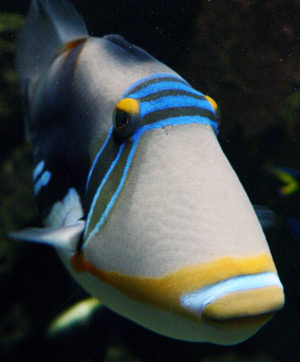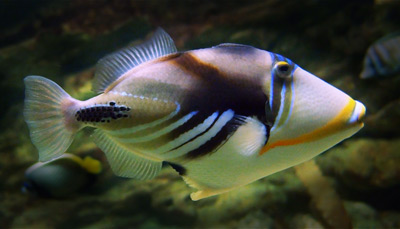Certain fishes available in the marine aquarium trade are truly bizarre in their coloration and patterning. Ranked high among them when it comes to both exotic appearance and aquarium adaptability is Rhinecanthus aculeatus, better known as the Picasso triggerfish or the Humuhumu triggerfish.
This latter appellation (which is also applied to the closely related and similar looking R. rectangulus) is derived from the Hawaiian name for the species: Humuhumu nukunuku apua’a, which, if memory serves, translates loosely into “Man, how many Mai Tais did I pack away last night!?” I could be wrong on that.
Physical traits

R. aculeatus exhibits “typical” triggerfish morphology, with a highly laterally compressed body; high-set, independently moving eyes positioned far back on the head; a deceptively small, forward-set mouth; and a stout first dorsal spine that can be “locked” in an upright position to secure the trigger in a reef crevice when the fish is threatened. The maximum recorded length for this species is around 10 inches.
I could try to describe the color and patterning of R. aculeatus, but it wouldn’t do this fish justice. Suffice it to say, the moniker “Picasso trigger” is apropos given this species’ almost surreal black, blue, yellow, and orangish-brown striping. You really have to see a specimen in photos or, better yet, in person to appreciate its beauty.
Feeding
According to Fishbase, in the wild, R. aculeatus feeds on algae, detritus, mollusks, crustaceans, worms, sea urchins, fishes, corals, tunicates, forams, and eggs. Examples of good options for captive feeding include various fresh seafoods (clams, shrimp, squid, etc.); frozen mysids, plankton, and krill; and frozen formulations for omnivores/herbivores. Multiple daily feedings are advised.
Housing
I’ve read/seen recommendations for keeping this species in tanks as small as 55 gallons. However, while a tank this size might suffice for a small specimen, it is grossly inadequate for an adult. In fact, I wouldn’t advise going any smaller than 125 gallons for this species. Also, keep in mind this trigger’s propensity to rearrange aquascaping and nibble on objects in its environment. Make sure all rockwork is well secured, and it’s wise to place heaters and other equipment down in a sump if possible.
Compatibility
R. aculeatus isn’t nearly as outright murderous as some balistids, which makes it one of the more community-friendly triggers. Still, it can be aggressive, some individuals more so than others. Any tankmates should be big enough to avoid being swallowed and tough enough to shrug off the trigger’s aggression if it should happen to “go rogue.”
Reef tank keeping cannot be recommended, as R. aculeatus will nip at or eat many types of invertebrates, both sessile and motile.



